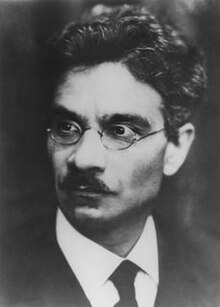Erwin Finlay-Freundlich
Erwin Finlay-Freundlich FRAS | |
|---|---|
 | |
| Born | 29 May 1885 |
| Died | 24 July 1964 (aged 79) , Hesse, Germany |
| Alma mater |
|
| Spouse |
Kate Hirschberg (m. 1913) |
| Scientific career | |
| Fields | Astronomy |
| Institutions |
|
| Thesis | Analytische Funktionen mit beliebig vorgeschriebenem unendlich-blättrigem Existenzbereiche (1910) |
| Doctoral advisor |
|

Erwin Finlay-Freundlich
Life
He was born in
In 1913 he married Kate Hirschberg.[3] After finishing his thesis under the direction of
On the recommendation of
In 1951 he was created John Napier Professor of Astronomy. On his retirement in 1959, he returned to his native town Wiesbaden and was appointed professor at the University of Mainz. Freundlich died in Wiesbaden, Germany on 24 July 1964.
Achievements
Freundlich researched the deflection of light rays passing close to the Sun. He proposed an experiment, during an eclipse, to verify the validity of Einstein's theory of general relativity. Freundlich's demonstration would have proven Newton's theories incorrect. He did conduct inconclusive tests on the prediction by Einstein's theory of gravitation-induced red shift of spectral lines in the Sun, using the solar observatories he had constructed in Potsdam and Istanbul. In 1953, he proposed with Max Born an alternative explanation of the red shifts observed in galaxies by a tired light model.
Publications
- Die Grundlagen der Einsteinschen Gravitationstheorie. Mit e. Vorw. von Albert Einstein. – Berlin : Springer, 1916. – 64 S.; 8
- Über die Rotverschiebung der Spektrallinien with Max Born (1953)
- Theoretische Bemerkungen zu Freundlichs Formel für die stellare Rotverschiebung (1953)
- Cosmology (1971)
References
- ISBN 978-0-387-31022-0. Archivedfrom the original on February 22, 2014. Retrieved August 22, 2012.
- ^ The Einstein Tower by Klaus Hentschel
- ^ ISBN 0-902-198-84-X. Archived from the original(PDF) on 2013-01-24. Retrieved 2016-06-14.
External links and resources
- Klaus Hentschel: The Einstein Tower An Intertexture of Dynamic Construction, Relativity Theory, and Astronomy, Stanford University Press, Stanford 1997.
- School of Mathematics and Statistics. "Erwin Finlay Freundlich". University of St Andrews, Scotland.
- Erwin Freundlich at the Mathematics Genealogy Project
